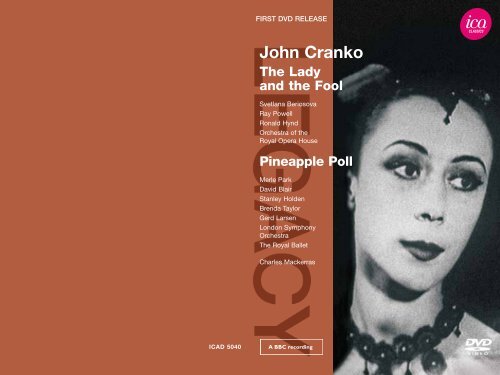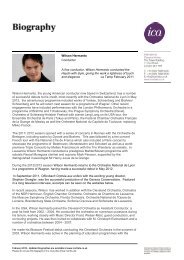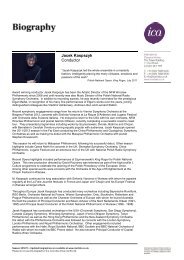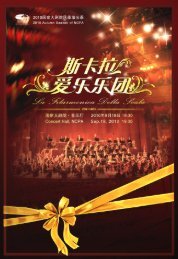to download the DVD booklet. - International Classical Artists
to download the DVD booklet. - International Classical Artists
to download the DVD booklet. - International Classical Artists
Create successful ePaper yourself
Turn your PDF publications into a flip-book with our unique Google optimized e-Paper software.
FIRST <strong>DVD</strong> RELEASE<br />
John Cranko<br />
The Lady<br />
and <strong>the</strong> Fool<br />
Svetlana Beriosova<br />
Ray Powell<br />
Ronald Hynd<br />
Orchestra of <strong>the</strong><br />
Royal Opera House<br />
Pineapple Poll<br />
Merle Park<br />
David Blair<br />
Stanley Holden<br />
Brenda Taylor<br />
Gerd Larsen<br />
London Symphony<br />
Orchestra<br />
The Royal Ballet<br />
Charles Mackerras<br />
ICAD 5040
THE LADY AND THE FOOL<br />
Choreography: © John Cranko<br />
Music: Giuseppe Verdi, arr. Charles Mackerras<br />
La Capricciosa . . . . . . . . . . . . . . . . . . . . . . . . . . . . . . . . . . . . . Svetlana Beriosova<br />
a beauty · une beauté · eine Schönheit<br />
Moondog . . . . . . . . . . . . . . . . . . . . . . . . . . . . . . . . . . . . . . . . . . . . . . . Ronald Hynd<br />
Bootface . . . . . . . . . . . . . . . . . . . . . . . . . . . . . . . . . . . . . . . . . . . . . . . . . Ray Powell<br />
clowns · Clowns<br />
Signor Midas . . . . . . . . . . . . . . . . . . . . . . . . . . . . . . . . . . . . . . . . . . . David Shields<br />
1 Opening Credits and Prologue (Moondog and Bootface) 5.05<br />
2 Entrance of La Capricciosa and Divertissement (Moondog and Bootface) 3.40<br />
3 Tarantella (Signor Midas, guests, La Capricciosa) 4.39<br />
4 Entrance of Moondog and Bootface 0.58<br />
5 Variation (La Capricciosa) 1.12<br />
6 Commedia (Moondog and Bootface) 6.19<br />
7 Grand Adage (La Capricciosa and sui<strong>to</strong>rs) 5.01<br />
8 Scene and Entrée (La Capricciosa, Moondog and Bootface) 1.05<br />
9 Variations (Signor Midas and Capitano Adoncino) 3.18<br />
10 Scene and Pas de deux (Moondog, La Capricciosa, Bootface) 5.46<br />
11 Finale (Signor Midas, guests, La Capricciosa, Moondog and Bootface) 3.38<br />
12 Epilogue (La Capricciosa, Moondog and Bootface) 4.17<br />
Capitano Adoncino . . . . . . . . . . . . . . . . . . . . . . . . . . . . . . . . . . . . . . Bob Stevenson<br />
The Prince of Arroganza . . . . . . . . . . . . . . . . . . . . . . . . . . . . . . . . . . . . Peter Wright<br />
Footman / Understudy . . . . . . . . . . . . . . . . . . . . . . . . . . . . . . . . . . . . Norman Pixon<br />
Un Laquais / Doublure · Ein Lakai / Ersatzspieler<br />
Coachman / Ensemble . . . . . . . . . . . . . . . . . . . . . . . . . . . . . . Graham McCormack<br />
Un Cocher / Ensemble · Ein Kutscher / Ensemble<br />
Orchestra of <strong>the</strong> Royal Opera House, Covent Garden<br />
Leader: Charles Taylor<br />
CHARLES MACKERRAS<br />
Narra<strong>to</strong>r: Dino Galvani<br />
Costumes: Jane Scrase Dickins<br />
Design: Guy Sheppard<br />
Producer: Margaret Dale<br />
License issued courtesy of G. Ricordi & Co. London Ltd<br />
Broadcast: 3 May 1959<br />
© BBC 1959<br />
2<br />
3
PINEAPPLE POLL<br />
Choreography: © John Cranko<br />
Music: Arthur Sullivan, arr. Charles Mackerras<br />
Poll . . . . . . . . . . . . . . . . . . . . . . . . . . . . . . . . . . . . . . . . . . . . . . . . . . . . . Merle Park<br />
a flower-seller · marchande de fleurs · Blumenverkäuferin<br />
Captain Belaye . . . . . . . . . . . . . . . . . . . . . . . . . . . . . . . . . . . . . . . . . . . . David Blair<br />
Jasper . . . . . . . . . . . . . . . . . . . . . . . . . . . . . . . . . . . . . . . . . . . . . . . Stanley Holden<br />
<strong>the</strong> pot boy · garçon de la taverne local · Laufjunge<br />
Blanche . . . . . . . . . . . . . . . . . . . . . . . . . . . . . . . . . . . . . . . . . . . . . . . Brenda Taylor<br />
Captain Belaye’s fiancée · fiancée au capitaine Belaye · mit Belaye verlobt<br />
Scene 1<br />
13 Opening Dance 3.45<br />
14 Poll’s solo – Pas de deux 3.46<br />
15 Captain Belaye’s Solo 3.30<br />
16 Pas de trois 3.13<br />
17 Finale 3.59<br />
Scene 2<br />
18 Poll’s Solo 3.34<br />
19 Jasper’s Solo 4.11<br />
Scene 3<br />
20 Belaye’s Solo – Sailors’ Drill 3.29<br />
21 Poll’s Solo 3.24<br />
22 Entry of Belaye with Blanche as Bride 2.45<br />
23 Reconciliation 3.07<br />
24 Grand Finale 5.10<br />
Mrs Dimple . . . . . . . . . . . . . . . . . . . . . . . . . . . . . . . . . . . . . . . . . . . . . . Gerd Larsen<br />
her aunt · sa tante · ihre Tante<br />
Cast of <strong>the</strong> Royal Ballet<br />
London Symphony Orchestra<br />
Leader: Hugh Maguire<br />
CHARLES MACKERRAS<br />
Design: Osbert Lancaster<br />
Producer: Margaret Dale<br />
Publisher: © Chappell Music Ltd. All rights reserved.<br />
Broadcast: 1 November 1959<br />
© BBC 1959<br />
4<br />
5
For ICA Classics<br />
Executive Producer: Stephen Wright<br />
Head of <strong>DVD</strong>: Louise Waller-Smith<br />
Executive Consultant: John Pattrick<br />
Music Rights Executive: Aurélie Baujean<br />
ICA Classics gratefully acknowledges <strong>the</strong> assistance of Bob Lockyer, Ernie Gilbert and Dieter Graefe<br />
<strong>DVD</strong> Studio Production<br />
<strong>DVD</strong> Design & Development: msm-studios GmbH<br />
Producer: Johannes Müller<br />
Project Management: Jakobus Ciolek<br />
Screen Design: Hermann Enkemeier<br />
<strong>DVD</strong> Authoring: Benjamin Fritz<br />
Audio Res<strong>to</strong>ration & Re-Mastering: Chris<strong>to</strong>ph Stickel<br />
Video Res<strong>to</strong>ration: Michael Hartl<br />
Subtitles prepared by<br />
<strong>DVD</strong> Packaging<br />
Product Management: Helen Forey & Harry Robson for WLP Ltd<br />
Booklet Editing: WLP Ltd<br />
Introduc<strong>to</strong>ry Note & Translations © 2011 <strong>International</strong> <strong>Classical</strong> <strong>Artists</strong> Ltd<br />
Cover Pho<strong>to</strong>: BBC<br />
Art Direction: Georgina Curtis for WLP Ltd<br />
π 2011 BBC, under licence <strong>to</strong> <strong>International</strong> <strong>Classical</strong> <strong>Artists</strong> Ltd<br />
PINEAPPLE POLL AND THE LADY AND THE FOOL<br />
John Cranko (1927–1973) was a master of <strong>the</strong> s<strong>to</strong>ry ballet. Though his work might have been<br />
considered anachronistic at a time when Neo-classicism had taken choreographic hold with <strong>the</strong><br />
dominance of George Balanchine, Cranko’s dance dramas have enjoyed enduring success. It isn’t<br />
simply that his best ballets were based on some of <strong>the</strong> greatest works of Shakespeare and Pushkin;<br />
Cranko’s fertile imagination created choreographic episodes of startling effect, shedding new light on<br />
familiar narratives. How fitting that John Percival’s excellent Cranko biography is titled, Theatre in My<br />
Blood! Theatricality is <strong>the</strong> essence of Cranko’s genius.<br />
Cranko’s evening-long masterpieces, Romeo and Juliet (1962), Onegin (1965) and The Taming of<br />
<strong>the</strong> Shrew (1969), confirmed his company, <strong>the</strong> Stuttgart Ballet, as a major player on <strong>the</strong> world ballet<br />
stage. That <strong>the</strong>se works have subsequently entered <strong>the</strong> reper<strong>to</strong>ire of many of <strong>the</strong> world’s leading<br />
ballet companies gives fur<strong>the</strong>r evidence of <strong>the</strong> universality of <strong>the</strong>ir value. And even though <strong>the</strong>y were<br />
originally tailored <strong>to</strong> <strong>the</strong> specific talents of Cranko’s great Stuttgart dancers, <strong>the</strong>y have found effective<br />
interpreters elsewhere. It is <strong>the</strong> dance, not just <strong>the</strong> dancer.<br />
Prior <strong>to</strong> Cranko’s stewardship of his Stuttgart troupe, his activities were confined <strong>to</strong> London. Born in<br />
South Africa, he moved <strong>to</strong> <strong>the</strong> UK capital when he was eighteen and soon <strong>the</strong>reafter joined <strong>the</strong><br />
Sadler’s Wells Ballet. However, it soon became clear <strong>to</strong> him and <strong>to</strong> <strong>the</strong> company’s direc<strong>to</strong>rs that his<br />
value <strong>to</strong> <strong>the</strong> company was not as a dancer, but as a choreographer. His first great success was <strong>the</strong><br />
rollicking comedy Pineapple Poll, which had its premiere on 13 March 1951 as part of an all-Cranko<br />
evening – quite an event for <strong>the</strong> budding choreographer!<br />
Pineapple Poll was <strong>the</strong> first collaboration between Cranko and Charles Mackerras, <strong>the</strong>n <strong>the</strong> assistant<br />
conduc<strong>to</strong>r of <strong>the</strong> Sadler’s Wells Opera. Mackerras felt that <strong>the</strong> music of Sir Arthur Sullivan, which<br />
had just fallen out of copyright, would serve admirably as a ballet score. He had conducted<br />
countless performances of Gilbert and Sullivan operettas and from close <strong>to</strong> a dozen of <strong>the</strong>m neatly<br />
stitched <strong>to</strong>ge<strong>the</strong>r a delightful musical setting for Cranko’s rambunctious ballet.<br />
ICA CLASSICS is a division of <strong>the</strong> management agency <strong>International</strong> <strong>Classical</strong> <strong>Artists</strong> Ltd (ICA). The label features archive material<br />
from sources such as <strong>the</strong> BBC, WDR in Cologne and <strong>the</strong> Bos<strong>to</strong>n Symphony Orchestra, as well as performances from <strong>the</strong> agency’s own<br />
artists recorded in prestigious venues around <strong>the</strong> world. The majority of <strong>the</strong> recordings are enjoying <strong>the</strong>ir first commercial release.<br />
The ICA Classics team has been instrumental in <strong>the</strong> success of many audio and audiovisual productions over <strong>the</strong> years, including<br />
<strong>the</strong> origination of <strong>the</strong> <strong>DVD</strong> series The Art of Conducting, The Art of Piano and The Art of Violin; <strong>the</strong> archive-based <strong>DVD</strong> series<br />
Classic Archive; co-production documentaries featuring artists such as Richter, Fricsay, Mravinsky and Toscanini; <strong>the</strong> creation of<br />
<strong>the</strong> BBC Legends archive label, launched in 1998 (now comprising more than 250 CDs); and <strong>the</strong> audio series Great Conduc<strong>to</strong>rs<br />
of <strong>the</strong> 20th Century produced for EMI Classics.<br />
WARNING: All rights reserved. Unauthorised copying, reproduction, hiring, lending, public performance and broadcasting<br />
prohibited. Licences for public performance or broadcasting may be obtained from Phonographic Performance Ltd.,<br />
1 Upper James Street, London W1F 9DE. In <strong>the</strong> United States of America unauthorised reproduction of this recording<br />
is prohibited by Federal law and subject <strong>to</strong> criminal prosecution.<br />
Made in Austria<br />
Principal characters in Pineapple Poll are Pineapple Poll, a flower-seller, Jasper, <strong>the</strong> ‘pot boy’ at <strong>the</strong><br />
local tavern and <strong>the</strong> dashing Captain Belaye of <strong>the</strong> H.M.S. Hot Cross Bun, which has just docked in<br />
Portsmouth. All <strong>the</strong> girls in <strong>to</strong>wn vie for <strong>the</strong> attention of Captain Belaye, including Pineapple Poll –<br />
much <strong>to</strong> <strong>the</strong> dismay of Jasper, who has a serious crush on her. But Belaye’s eye has been caught by<br />
Blanche, a local beauty shepherded by her aunt, Mrs Dimple.<br />
The besotted young ladies of Portsmouth resort <strong>to</strong> some extravagant shenanigans <strong>to</strong> get close <strong>to</strong><br />
Belaye, including cross-dressing as sailors in order <strong>to</strong> board his ship. The next morning, when <strong>the</strong><br />
Captain is taking his crew through <strong>the</strong>ir drill, he doesn’t seem <strong>to</strong> realise that <strong>the</strong>y are much smaller<br />
in build, that <strong>the</strong>re is quite a disparity in <strong>the</strong>ir heights and that Pineapple Poll is doing her exercises<br />
en pointe. He may well be distracted, for that very morning, with <strong>the</strong> approval of Mrs Dimple, he has<br />
married Blanche. Eventually, all is revealed. The Captain is promoted <strong>to</strong> Admiral, Jasper becomes<br />
<strong>the</strong> new Captain of H.M.S. Hot Cross Bun through <strong>the</strong> machinations of Mrs Dimple, Pineapple Poll<br />
immediately shifts her affections from Admiral Belaye <strong>to</strong> Captain Jasper, and <strong>the</strong> <strong>to</strong>wn’s girls reunite<br />
6<br />
7
with <strong>the</strong>ir disgruntled swains. David Blair, who danced <strong>the</strong> role of Captain Belaye at <strong>the</strong> ballet’s 1951<br />
premiere, recreated his performance for <strong>the</strong> 1959 telecast seen on this <strong>DVD</strong>.<br />
For <strong>the</strong> musical setting for The Lady and <strong>the</strong> Fool, Mackerras turned <strong>to</strong> <strong>the</strong> music of Verdi, extracting<br />
less familiar music from fifteen of his operas. He managed <strong>to</strong> fashion a particularly effective score<br />
for <strong>the</strong> somewhat darker mood of this second collaboration with Cranko, who provided both <strong>the</strong><br />
scenario and choreography.<br />
The Lady and <strong>the</strong> Fool premiered in Oxford on 25 February 1954, <strong>the</strong> London premiere taking place at<br />
Sadler’s Wells Theatre just a month later. It did not enjoy <strong>the</strong> immediate initial success of Pineapple<br />
Poll. Cranko’s choreography for <strong>the</strong> corps de ballet in <strong>the</strong> central ballroom scene lacked his usual<br />
inventiveness; he seemed <strong>to</strong> be creatively coasting. And he was not helped by his designer, who had<br />
worked mostly as a painter and had little experience in <strong>the</strong> <strong>the</strong>atre arts. Cranko had <strong>the</strong> opportunity <strong>to</strong><br />
rework <strong>the</strong> ballet for a Covent Garden opening on 9 July 1955 and it was much more tightly focused.<br />
Some of <strong>the</strong> ancillary characters were dropped completely, helping <strong>to</strong> emphasise <strong>the</strong> relationships<br />
among <strong>the</strong> principal protagonists. The décor was also greatly improved, and <strong>the</strong> orchestra was<br />
augmented, resulting in a more luxurious soundscape.<br />
The three main charaters in The Lady and <strong>the</strong> Fool are two itinerant clowns, Moondog and Bootface,<br />
and La Capricciosa, a masked beauty. Moondog and Bootface have fallen asleep on a bench near <strong>the</strong><br />
palace of Signor Midas. La Capricciosa passes <strong>the</strong> clowns on her way <strong>to</strong> <strong>the</strong> palace, where a ball is<br />
being held, and she invites <strong>the</strong>m <strong>to</strong> join her.<br />
At <strong>the</strong> masked ball, <strong>the</strong> clowns entertain <strong>the</strong> guests while La Capricciosa is pursued by three of<br />
Signor Midas’ aris<strong>to</strong>cratic guests, but she rejects <strong>the</strong>m, and when she is finally alone, she removes<br />
her mask as Moondog enters <strong>the</strong> ballroom. He instantly falls in love with her and she with him,<br />
much <strong>to</strong> <strong>the</strong> consternation of her o<strong>the</strong>r sui<strong>to</strong>rs and of Bootface, who has unsuccessfully tried <strong>to</strong><br />
attract some of <strong>the</strong> debutantes at <strong>the</strong> ball. La Capricciosa and Moondog leave <strong>to</strong>ge<strong>the</strong>r, but return <strong>to</strong><br />
take Bootface with <strong>the</strong>m. In <strong>the</strong> final scene, <strong>the</strong> trio returns <strong>to</strong> <strong>the</strong> bench where <strong>the</strong> clowns were<br />
sleeping earlier and curls up <strong>to</strong> sleep as <strong>the</strong> curtain falls.<br />
Both Pineapple Poll and The Lady and <strong>the</strong> Fool remained in <strong>the</strong> reper<strong>to</strong>ire of <strong>the</strong> Sadler’s Wells Ballet<br />
with sporadic revivals and with productions in o<strong>the</strong>r companies, as well. When <strong>the</strong> company, by <strong>the</strong>n<br />
<strong>the</strong> Royal Ballet, <strong>to</strong>ured Russia, The Lady and <strong>the</strong> Fool was its most popular offering. Quite possibly,<br />
<strong>the</strong> plight of <strong>the</strong> homeless Moondog and Bootface and <strong>the</strong>ir ultimate embrace by <strong>the</strong> seemingly<br />
unattainable La Capricciosa struck a sympa<strong>the</strong>tic chord with <strong>the</strong> Russian audiences.<br />
Cranko’s subsequent work for his Suttgart company embraced a much larger vision than <strong>the</strong>se<br />
delightful diversions he created for London, and he was given all <strong>the</strong> resources he needed <strong>to</strong> realise<br />
it. He was just forty-five when he died on a transatlantic flight following a wildly successful New York<br />
engagement by his company. One can only conjecture what might have been had death not so<br />
rudely intervened.<br />
Ernie Gilbert<br />
PINEAPPLE POLL ET THE LADY AND THE FOOL<br />
John Cranko (1927–1973) était un maître du ballet narratif. Bien que son travail puisse être<br />
considéré comme anachronique à une époque où le néoclassicisme s’était imposé dans le monde<br />
de la danse avec la domination de George Balanchine, les drames dansés de Cranko ont connu un<br />
succès durable. Ce n’est pas simplement que ses meilleurs ballets étaient fondés sur certaines des<br />
plus grandes œuvres de Shakespeare et de Pouchkine; l’imagination fertile de Cranko donna le<br />
jour à des épisodes chorégraphiques d’un effet saisissant, jetant une lumière nouvelle sur des<br />
récits connus. L’excellente biographie de Cranko signée par John Percival est très justement<br />
intitulée Theatre in My Blood ! (Théâtre dans mon sang). La théâtralité est en effet l’essence du<br />
génie de Cranko.<br />
Les chefs-d’œuvre de Cranko qui remplissent <strong>to</strong>ute une soirée, Roméo et Juliette (1962), Onéguine<br />
(1965) et La Mégère apprivoisée (1969), confirmaient que sa compagnie, le Ballet de Stuttgart, était<br />
un acteur majeur sur la scène chorégraphique mondiale. Le fait que ces œuvres soient ensuite<br />
entrées au réper<strong>to</strong>ire de bon nombre des plus grandes compagnies de ballet au monde confirme<br />
l’universalité de leur valeur. Et même si elles étaient au départ conçues sur mesure pour les talents<br />
spécifiques des grands danseurs de Cranko à Stuttgart, elles ont trouvé d’éloquents interprètes<br />
ailleurs. Leur réussite tient à la danse, et non seulement aux danseurs.<br />
Avant que Cranko ne prenne la direction de sa troupe à Stuttgart, ses activités étaient confinées à<br />
Londres. Né en Afrique du Sud, il s’établit dans la capitale britannique à l’âge de dix-huit ans et<br />
rejoignit peu de temps après le Sadler’s Wells Ballet. Toutefois, lui-même et les directeurs de la<br />
compagnie comprirent bientôt clairement que ce n’était pas en tant que danseur qu’il était précieux<br />
pour la compagnie, mais en tant que chorégraphe. Son premier grand succès fut la comédie<br />
délirante Pineapple Poll, créée le 13 mars 1951 dans le cadre d’une soirée entièrement consacrée à<br />
Cranko – événement de taille pour le jeune chorégraphe!<br />
Pineapple Poll fut la première collaboration entre Cranko et Charles Mackerras, alors chef assistant<br />
du Sadler’s Wells Opera. Mackerras avait le sentiment que la musique de Sir Arthur Sullivan, qui<br />
venait de <strong>to</strong>mber dans le domaine public, conviendrait admirablement à une partition de ballet.<br />
Il avait dirigé d’innombrables représentations d’opérettes de Gilbert et Sullivan et, à partir de<br />
près d’une douzaine d’entre elles, assembla un charmant cadre musical pour l’exubérant ballet<br />
de Cranko.<br />
Les principaux personnages de Pineapple Poll sont Pineapple Poll, une marchande de fleurs, Jasper,<br />
le “garçon” de la taverne locale, et le fringant capitaine Belaye de H.M.S. Hot Cross Bun, qui vient<br />
d’accoster à Portsmouth. Toutes les jeunes filles de la ville se disputent l’attention du capitaine<br />
Belaye, y compris Pineapple Poll – au grand désarroi de Jasper, très épris d’elle. Mais c’est<br />
Blanche, une beauté locale chaperonnée par sa tante, Mrs Dimple, qui a capté le regard de Belaye.<br />
Les jeunes filles de Portsmouth entichées du capitaine recourent à d’extravagants stratagèmes pour<br />
8<br />
9
se rapprocher de Belaye, se déguisant notamment en marins pour monter à bord de son navire. Le<br />
lendemain matin, alors que le capitaine parle à son équipage pendant l’exercice, il ne semble pas se<br />
rendre compte qu’elles sont de constitution beaucoup plus petite, qu’il y a une grande disparité<br />
dans leurs tailles, et que Pineapple Poll fait ses exercices en pointes. Il pourrait bien être distrait, car<br />
ce matin même, avec l’approbation de Mrs Dimple, il a épousé Blanche. Par la suite, <strong>to</strong>ut est révélé.<br />
Le capitaine est promu amiral, Jasper devient le nouveau capitaine de H.M.S. Hot Cross Bun grâce<br />
aux machinations de Mrs Dimple, Pineapple Poll reporte aussitôt son affection pour l’amiral Belaye<br />
sur le capitaine Jasper, et les jeunes filles retrouvent leurs soupirants contrariés. David Blair, qui<br />
dansa le rôle du capitaine Belaye lors de la première du ballet en 1951, recréa son interprétation<br />
pour la retransmission télévisée de 1959 vue sur ce <strong>DVD</strong>.<br />
Pour la musique de The Lady and <strong>the</strong> Fool, Mackerras se <strong>to</strong>urna vers l’œuvre de Verdi, empruntant<br />
des pages moins connues à quinze de ses opéras. Il réussit à façonner une partition particulièrement<br />
réussie pour le climat un peu plus sombre de sa deuxième collaboration avec Cranko, qui signa à la<br />
fois le scénario et la chorégraphie.<br />
The Lady and <strong>the</strong> Fool fut créé à Oxford le 25 février 1954, et la première londonienne eut lieu au<br />
Sadler’s Wells Theatre à peine un mois plus tard. L’œuvre n’eut pas le succès initial immédiat de<br />
Pineapple Poll. La chorégraphie de Cranko pour le corps de ballet, dans la scène centrale de la<br />
salle de bal, n’avait pas son invention habituelle; il semblait plafonner sur le plan créatif. Et son<br />
décorateur, qui travailla essentiellement en peintre et avait peu d’expérience du théâtre, ne l’avait pas<br />
aidé. Cranko eut l’occasion de retravailler le ballet pour une première représentation à Covent Garden<br />
le 9 juillet 1955, et le spectacle était alors beaucoup plus précisément articulé. Certains des<br />
personnages secondaires furent entièrement abandonnés, ce qui aidait à souligner les relations entre<br />
les principaux protagonistes. Le décor fut lui aussi considérablement amélioré, et l’orchestre é<strong>to</strong>ffé,<br />
ce qui donnait un paysage sonore plus luxueux.<br />
Les trois personnages principaux de The Lady and <strong>the</strong> Fool sont deux clowns itinérants, Moondog et<br />
Bootface, et La Capricciosa, une beauté masquée. Moondog et Bootface se sont endormis sur un<br />
banc près du palais de Signor Midas. La Capricciosa passe devant les clowns en route pour le<br />
palais, où l’on donne un bal, et les invite à se joindre à elle.<br />
Au bal masqué, les clowns divertissent les invités, tandis que trois des aris<strong>to</strong>crates conviés par<br />
Signor Midas courtisent La Capricciosa; mais elle les rejette et, quand elle est enfin seule, ôte son<br />
masque au moment où Moondog entre dans la salle de bal. Ils <strong>to</strong>mbent aussitôt amoureux l’un de<br />
l’autre, à la grande consternation des autres prétendants et de Bootface, qui a essayé en vain d’attirer<br />
certaines des débutantes. La Capricciosa et Moondog partent ensemble, mais reviennent pour<br />
emmener Bootface avec eux. Dans la scène finale, le trio re<strong>to</strong>urne au banc où les clowns dormaient<br />
un peu plus tôt et s’installe pour dormir tandis que le rideau <strong>to</strong>mbe.<br />
Pineapple Poll et The Lady and <strong>the</strong> Fool restèrent <strong>to</strong>us deux au réper<strong>to</strong>ire du Sadler’s Wells Ballet,<br />
avec des reprises sporadiques, ainsi que des productions par d’autres compagnies. Lorsque la<br />
compagnie, alors devenue le Royal Ballet, fit une <strong>to</strong>urnée en Russie, The Lady and <strong>the</strong> Fool fut son<br />
spectacle le plus apprécié. Il est fort possible que la situation des clowns sans abri, Moondog et de<br />
Bootface, qui finissent par susciter l’affection de Capricciosa, apparemment inaccessible, ait trouvé<br />
des échos de sympathie parmi le public russe.<br />
Cranko adopta dans son travail ultérieur pour sa compagnie de Stuttgart une vision beaucoup plus<br />
large que dans ces charmants divertissements qu’il conçut pour Londres, et on lui donna <strong>to</strong>us les<br />
moyens dont il avait besoin pour la réaliser. Il avait seulement quarante-cinq ans quand il mourut<br />
sur un vol transatlantique après un spectacle triomphal de sa compagnie à New York. On ne peut<br />
que supposer ce qu’il serait devenu si la mort n’était pas intervenue aussi brutalement.<br />
PINEAPPLE POLL UND THE LADY AND THE FOOL<br />
Ernie Gilbert<br />
Traduction : Dennis Collins<br />
John Cranko (1927–1973) war ein Meister des Handlungsballetts. Auch wenn seine Arbeit in einer<br />
Zeit, in der die Choreographie im Zeichen des Neoklassizismus von George Balanchine beherrscht<br />
wurde, als anachronistisch hätte gelten können, genossen Crankos Tanzdramen anhaltenden Erfolg.<br />
Das liegt nicht einfach nur daran, dass seine besten Ballette auf einigen der bedeutendsten Werke<br />
Shakespeares und Puschkins basierten; Crankos fruchtbare Phantasie schuf choreographische<br />
Episoden von verblüffender Wirkung, die bekannte Geschichten in ein neues Licht rückten. Aus<br />
gutem Grund trägt John Percivals ausgezeichnete Cranko-Biographie im englischen Original den Titel<br />
Theatre in My Blood! (deutsch: John Cranko). Was Crankos Genie ausmacht, ist die<br />
Theaterwirksamkeit seiner Choreographien.<br />
Crankos abendfüllende Meisterwerke, Romeo und Julia (1962), Onegin (1965) und Der<br />
Widerspenstigen Zähmung (1969), begründeten den Weltruf seines Stuttgarter Balletts. Dass diese<br />
Werke anschließend in das Reper<strong>to</strong>ire zahlreicher führender Ballettruppen Eingang fanden, zeigt ihre<br />
universelle Gültigkeit. Und obwohl sie ursprünglich auf die besonderen Talente der großartigen<br />
Stuttgarter Tänzer in Crankos Truppe zugeschnitten waren, fanden sie auch anderswo überzeugende<br />
Darsteller. Was zählt, ist der Tanz, nicht bloß der Tänzer.<br />
Bevor Cranko die Leitung des Stuttgarter Balletts übernahm, war er in London tätig. In Südafrika<br />
gebürtig, kam er mit 18 Jahren nach London und wurde bald darauf Mitglied des Sadler’s Wells<br />
Ballet. Dort wurde ihm und den Direk<strong>to</strong>ren des Balletts allerdings bald klar, dass seine Stärke nicht<br />
im Tanz, sondern in der Choreographie lag. Sein erster großer Erfolg war die übermütige Komödie<br />
Pineapple Poll, deren Premiere am 13. März 1951 als Teil eines allein von Cranko gestalteten<br />
Programms stattfand – eine beachtliche Leistung für einen Choreographen am Beginn seiner<br />
Laufbahn!<br />
10 11
Pineapple Poll war die erste Zusammenarbeit zwischen Cranko und Charles Mackerras, dem<br />
damaligen Assistant Conduc<strong>to</strong>r der Sadler’s Wells Opera. Mackerras fand die Musik von Sir Arthur<br />
Sullivan, deren Urheberrechte gerade abgelaufen waren, wunderbar als Ballettmusik geeignet. Er<br />
hatte zahllose Aufführungen der Operetten von Gilbert und Sullivan dirigiert und aus fast einem<br />
Dutzend von ihnen eine entzückende Musik für Crankos umwerfendes Ballett zusammengestellt.<br />
Die Hauptfiguren in Pineapple Poll sind Pineapple Poll, eine Blumenverkäuferin, Jasper, der<br />
Laufjunge im örtlichen Gasthaus sowie der schneidige Kapitän Belaye der H.M.S. Hot Cross Bun,<br />
die gerade in Portsmouth angelegt hat. Alle Mädchen der Stadt himmeln Kapitän Belaye an, auch<br />
Pineapple Poll – was wiederum Jasper sehr betrübt, der sich ernsthaft in sie verliebt hat. Aber Belaye<br />
interessiert sich für Blanche, eine lokale Schönheit, die in der Obhut ihrer Tante Mrs Dimple lebt.<br />
Die liebes<strong>to</strong>llen jungen Damen von Portsmouth verfallen auf merkwürdige Machenschaften, um<br />
Belaye näherzukommen, indem sie sich z. B. als Seeleute verkleiden, um an Bord seines Schiffes zu<br />
gelangen. Als der Kapitän am nächsten Morgen seine Mannschaft exerzieren lässt, scheint er nicht<br />
zu bemerken, dass sie alle kleiner geworden und unterschiedlich groß sind und dass Pineapple Poll<br />
ihre Übungen en pointe (auf Zehenspitzen) ausführt. Er hat gute Gründe, unaufmerksam zu sein, weil<br />
er gerade an diesem Morgen mit dem Segen von Mrs Dimple Blanche geheiratet hat. Schließlich<br />
klärt sich alles auf. Der Kapitän wird zum Admiral befördert, Jasper wird dank der Intrigen von Mrs<br />
Dimple zum neuen Kapitän der H.M.S. Hot Cross Bun ernannt, worauf Pineapple Poll unverzüglich<br />
ihre Zuneigung von Admiral Belaye zu Kapitän Jasper verlagert, während die Stadtmädchen sich<br />
wieder ihren verärgerten Bauernburschen zuwenden. David Blair, der die Rolle des Kapitän Belaye bei<br />
der Premiere im Jahr 1951 getanzt hatte, übernahm die gleiche Rolle bei der Fernsehaufnahme von<br />
1959, die auf dieser <strong>DVD</strong> zu sehen ist.<br />
Für die musikalische Untermalung von The Lady and <strong>the</strong> Fool griff Mackerras auf Musik von Verdi<br />
zurück und gestaltete weniger bekannte Auszüge aus 15 Verdi-Opern zu einer besonders effektvollen<br />
Partitur für die nicht ganz so heitere Stimmung dieses zweiten Gemeinschaftsprojektes mit Cranko,<br />
der Szenario und Choreographie besorgte.<br />
Die drei Hauptfiguren in The Lady and <strong>the</strong> Fool sind zwei vagabundierende Clowns, Moondog<br />
und Bootface, sowie La Capricciosa, eine maskierte Schönheit. Moondog und Bootface sind<br />
auf einer Bank in der Nähe des Palastes von Signor Midas eingeschlafen. La Capricciosa<br />
kommt auf ihrem Weg zum Palast, in dem ein Ball stattfindet, an den Clowns vorbei und lädt diese<br />
ein, sie zu begleiten.<br />
Auf dem Maskenball unterhalten die Clowns die Gäste, während La Capricciosa von drei adligen<br />
Gästen von Signor Midas verfolgt wird, die sie aber zurückweist; endlich allein nimmt sie die Maske<br />
ab, da betritt Moondog den Ballsaal. Er verliebt sich Hals über Kopf in sie und sie sich in ihn, was<br />
wiederum ihre Verehrer und Bootface empört, der vergeblich auf dem Ball versucht hat, sich einigen<br />
der Debütantinnen zu nähern. La Capricciosa und Moondog verlassen gemeinsam den Palast, drehen<br />
aber noch einmal um, um Bootface mitzunehmen. In der Schlussszene kehren die drei zur Bank<br />
zurück, auf der die Clowns vorher eingeschlafen waren, und sinken in Schlaf, als der Vorhang fällt.<br />
Sowohl Pineapple Poll als auch The Lady and <strong>the</strong> Fool blieben weiter im Reper<strong>to</strong>ire des Sadler’s<br />
Wells Ballet mit sporadischen Wiederaufnahmen sowie Inszenierungen anderer Ballettruppen.<br />
Während ihrer Tournee durch Russland war The Lady and <strong>the</strong> Fool das populärste Stück der<br />
inzwischen zum Royal Ballet avancierten Truppe. Wahrscheinlich haben die Misere der heimatlosen<br />
Clowns Moondog und Bootface und endlich die Umarmung durch die scheinbar unnahbare<br />
La Capricciosa beim russischen Publikum eine mitfühlende Saite berührt.<br />
Crankos anschließende Arbeit mit seiner Stuttgarter Truppe wurde von einer weitaus breiteren Vision<br />
getragen als diese entzückenden Londoner Werke, und er bekam alle Mittel, die er zu ihrer<br />
Realisierung brauchte. Er war erst 45, als er nach einem sehr erfolgreichen New Yorker Gastspiel<br />
seiner Truppe auf dem Rückflug starb. Man kann nur mutmaßen, was er noch hätte erreichen können,<br />
wenn der Tod ihn nicht so grausam ereilt hätte.<br />
Ernie Gilbert<br />
Übersetzung: Christiane Frobenius<br />
The Lady and <strong>the</strong> Fool wurde am 25. Februar 1954 in Oxford uraufgeführt; die Londoner Premiere<br />
fand nur einen Monat später im Sadler’s Wells Theatre statt. Das Werk erzielte nicht sofort den<br />
gleichen Anfangserfolg wie Pineapple Poll. Crankos Choreographie für das corps de ballet in der<br />
zentralen Ballsaalszene ließ seinen gewohnten Einfallsreichtum vermissen; er scheint sich nur mit<br />
halber schöpferischer Kraft eingesetzt zu haben. Auch fand er keine Unterstützung in seinem<br />
Bühnenbildner, der hauptsächlich als Maler gearbeitet und kaum Erfahrung mit dem Theater hatte.<br />
Cranko bekam Gelegenheit, das Werk für seine Covent Garden-Premiere am 9. Juli 1955<br />
umzuarbeiten und zu straffen. Einige Nebenfiguren entfielen gänzlich, so dass die Beziehungen<br />
zwischen den Hauptfiguren klarer hervortraten. Außerdem wurde die Bühnenausstattung wesentlich<br />
verbessert und das Orchester vergrößert, was zu einem üppigeren Klangbild beitrug.<br />
12 13
Also available from ICA Classics:<br />
ICAD 5009<br />
R. Strauss: Ein Heldenleben<br />
Dvořák: Symphony No.9 ‘From <strong>the</strong><br />
New World’<br />
Royal Philharmonic Orchestra<br />
BBC Symphony Orchestra<br />
Rudolf Kempe<br />
ICAD 5010<br />
Schubert: Piano Trios<br />
Beaux Arts Trio<br />
ICAD 5013<br />
Brahms: Piano Concer<strong>to</strong> No.2<br />
Garrick Ohlsson<br />
BBC Symphony Orchestra<br />
James Loughran<br />
ICAD 5014<br />
Debussy: La Mer · Ibéria<br />
Ravel: Ma Mère l’Oye Suite<br />
Bos<strong>to</strong>n Symphony Orchestra<br />
Charles Munch<br />
ICAD 5011<br />
Elgar: Symphony No.2 · Enigma Variations<br />
London Philharmonic Orchestra<br />
Sir Georg Solti<br />
ICAD 5012<br />
Bach: Concer<strong>to</strong> for two violins · Mozart: Sinfonia<br />
concertante · Brahms: Violin Concer<strong>to</strong><br />
David Oistrakh · Igor Oistrakh<br />
English Chamber Orchestra · Sir Colin Davis<br />
Moscow Philharmonic Orchestra<br />
Yehudi Menuhin · Kirill Kondrashin<br />
ICAD 5015<br />
Wagner: Orchestral excerpts<br />
from Die Meistersinger<br />
Franck: Symphony in D minor<br />
Fauré: Pelléas et Mélisande Suite<br />
Bos<strong>to</strong>n Symphony Orchestra<br />
Charles Munch<br />
14 15<br />
ICAD 5016<br />
Beethoven: Symphonies Nos.4 & 5<br />
Die Geschöpfe des Prome<strong>the</strong>us (extracts)<br />
Bos<strong>to</strong>n Symphony Orchestra<br />
Charles Munch
ICAD 5017<br />
Szymanowski: Symphony No.3 ‘The Song<br />
of <strong>the</strong> Night’ · Symphony No.4<br />
‘Concertante’<br />
RafaI/ Bartmiński · Jan Krzysz<strong>to</strong>f Broja<br />
Warsaw Philharmonic · An<strong>to</strong>ni Wit<br />
ICAD 5018<br />
Mahler: Symphony No.6<br />
La Monnaie Symphony Orchestra<br />
Hartmut Haenchen<br />
ICAD 5027<br />
Glinka: Ruslan and Lyudmila<br />
Three Dances from ‘A Life for <strong>the</strong> Tsar’<br />
Tchaikovsky: The Nutcracker – Act II<br />
BBC Symphony Orchestra<br />
Gennadi Rozhdestvensky<br />
ICAD 5028<br />
Haydn: Symphony No.98<br />
Bruckner: Symphony No.7<br />
Bos<strong>to</strong>n Symphony Orchestra<br />
Charles Munch<br />
ICAD 5024<br />
Wagner: Der fliegende Holländer – Overture<br />
R. Strauss: Don Juan<br />
Beethoven: Symphony No.5<br />
Orchestra of <strong>the</strong> Royal Opera House<br />
BBC Symphony Orchestra<br />
Sir Georg Solti<br />
ICAD 5026<br />
Viennese Night at <strong>the</strong> BBC Proms<br />
Johann Strauss I & II · Lehár · Suppé<br />
Sheila Armstrong · János Fürst<br />
James Loughran · Walter Susskind<br />
ICAD 5029<br />
Brahms: Symphonies Nos.1 & 2<br />
Bos<strong>to</strong>n Symphony Orchestra<br />
Charles Munch<br />
16 17<br />
ICAD 5030<br />
Les Sylphides · Giselle<br />
Svetlana Beriosova · Violetta Elvin<br />
Alicia Markova · John Field<br />
Nadia Nerina · Nikolai Fadeyechev<br />
Niels Bjørn Larsen · Lydia Sokolova<br />
Margaret Hill
ICAD 5031<br />
R. Strauss: Till Eulenspiegel<br />
Ein Heldenleben<br />
Includes introductions & educational guides<br />
London Symphony Orchestra<br />
Michael Tilson-Thomas<br />
ICAD 5037<br />
Vaughan Williams: Symphony No.8<br />
Job: A Masque for Dancing<br />
London Philharmonic Orchestra<br />
Sir Adrian Boult<br />
ICAD 5041<br />
Mahler: Symphony No.5<br />
London Philharmonic Orchestra<br />
Klaus Tennstedt<br />
ICAD 5042<br />
Schumann: Symphony No.4<br />
Mahler: Das Lied von der Erde<br />
Carolyn Watkinson · John Mitchinson<br />
BBC Philharmonic Orchestra<br />
Kurt Sanderling<br />
ICAD 5038<br />
Rachmaninov: The Bells<br />
Prokofiev: Lieutentant Kijé<br />
Sheila Armstrong · Robert Tear<br />
John Shirley-Quirke<br />
London Philharmonic Orchestra and Chorus<br />
André Previn<br />
ICAD 5039<br />
Mendelssohn: Symphonies No.3 ‘Scottish’<br />
& No.4 ‘Italian’<br />
Bos<strong>to</strong>n Symphony Orchestra<br />
Charles Munch<br />
ICAD 5043<br />
Schubert: Symphony No.9 ‘Great’<br />
Schumann: Symphony No.4<br />
Wagner: Good Friday Music from Parsifal<br />
Bos<strong>to</strong>n Symphony Orchestra<br />
Erich Leinsdorf<br />
ICAD 5044<br />
Schubert: String Quartets Nos.10 & 12<br />
Brahms: String Quartet No.2<br />
Borodin Quartet<br />
18 19

















